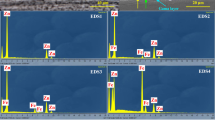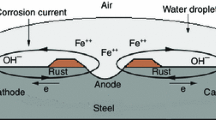Abstract
The corrosion behavior of formic acid towards bronze under thin electrolyte layer (TEL) was investigated by means of electrochemical measurement. Bare bronze had smaller self-corrosion current density than Cu2O patina bronze and CuCl patina bronze, while it had higher polarization resistance. The corrosion behavior of bronze materials had differences in various TELs and bulk solutions. The critical thickness of TEL for Bare Bronze was 200 µm, which normly occurred in the transformation from anode control to cathode control. The thickness of TEL had a negligible effect on the corrosion rate of Cu2O patina bronze when it was greater than 150 µm. For CuCl patina bronze, the corrosion process accelerated with thinner TEL. SEM was used to analyze the morphology and composition of corrosion products. Cu2O,Cu(OH)(HCOO) and Cu(HCOO)2 were formed on the surface of Bare Bronze and Cu2O patina bronze, nevertheless, the main corrosion product of CuCl patina bronze was Cu2Cl(OH)3.
Similar content being viewed by others
References
Prosek T, Taube M, Dubois F, et al. Application of Automated Electrical Resistance Sensors for Measurement of Corrosion Rate of Copper, Bronze and Iron in Model Indoor Atmospheres Containing Short-chain Volatile Carboxylic Acids[J]. Corros. Sci., 2014, 87: 376–382
Gibson L T, Watt C M. Acetic and Formic Acids Emitted from Wood Samples and Their Effect on Selected Materials in Museum Environments[J]. Corros. Sci., 2010, 52(1): 172–178
Martellini T, Berlangieri C, Dei L, et al. Indoor Levels of Volatile Organic Compounds at Florentine Museum Environments in Italy[J]. Indoor Air, 2020, 30(5): 900–913
Schieweck A, Lohrengel B, Siwinski N, et al. Organic and Inorganic Pollutants in Storage Rooms of the Lower Saxony State Museum Hanover, Germany[J]. Atmos. Environ., 2005, 39(33): 6098–6108
Allen A G, Miguel A H. Indoor Organic and Inorganic Pollutants: In-situ Formation and Dry Deposition in Southeastern Brazil[J]. Atmos. Environ., 1995, 29(23): 3519–3526
Gibson L T, Cooksey B G, Littlejohn D, et al. A Diffusion Tube Sampler for the Determination of Acetic Acid and Formic Acid Vapours in Museum Cabinets[J]. Anal. Chim. Acta, 1997, 341(1): 11–19
Robinet L, Eremin K, Coupry C, et al. Effect of Organic Acid Vapors on the Alteration of Soda Silicate Glass[J]. J. Non-Cryst. Solids, 2007, 353(16–17): 1546–1559
Rocca E, Rapin C, Mirambet F. Inhibition Treatment of the Corrosion of Lead Artefacts in Atmospheric Conditions and by Acetic Acid Vapour: Use of Sodium Decanoate[J]. Corros. Sci., 2004, 46(3): 653–665
Ghiara G, Campodonico S, Piccardo P, et al. Micro Raman Investigation on Corrosion of Pb-based Alloy Replicas of Letters from the Museum Plantin-Moretus, Antwerp[J]. J. Raman Spectrosc., 2014, 45(11–12): 1093–1102
Bastidas D M, Cayuela I, Bastidas J M. Ant-nest Corrosion of Copper Tubing in Air-conditioning Units[J]. Rev. Metal Madrid., 2006, 42(5): 367–381
Forslund M, Leygraf M, Claesson P M, et al. Micro-Galvanic Corrosion Effects on Patterned Copper-Zinc Samples during Exposure in Humidified Air Containing Formic Acid[J]. J. Electrochem. Soc., 2013, 160(9): C423–C431
George K S, Nesic S. Investigation of Carbon Dioxide Corrosion of Mild Steel in the Presence of Acetic Acid - Part 1: Basic Mechanisms [J]. Corrosion (Houston, TX, U. S.), 2007, 63(2): 178–186
Chen C, Cai L, Wang X, et al. Corrosion Behavior of Bronze under Organic Acid-containing Thin Electrolyte Layer[J]. Mater. Corros., 2019, 70(2): 319–327
Nishikata A. Electrochemical Measurements under Thin Solution Films and the Application to Atmospheric Corrosion Study[J]. Zairyo to Kankyo, 2016, 65(4): 120–126
Liao X, Cao F, Zhang J. Effect of Sulphate on the Corrosion Behavior of Bronze under a Chloride-containing Thin Electrolyte Layer[J]. Mater. Corros., 2018, 69(10): 1412–1421
Masi G, Esvan J, Josse C, et al. Characterization of Typical Patinas Simulating Bronze Corrosion in Outdoor Conditions[J. Mater. Chem. Phys., 2017, 200: 308–321
Wang Z, Li Y, Jiang X, et al. Research Progress on Ancient Bronze Corrosion in Different Environments and Using Different Conservation Techniques: A Review[J]. MRS Adv., 2017, 2: 2033–2041
Yang F, Kang H, Guo E, et al. The Role of Nickel in Mechanical Performance and Corrosion Behaviour of Nickel-Aluminium Bronze in 3.5 wt.% NaCl Solution[J]. Corros. Sci., 2018, 139: 333–345
Liao X, Cao F, Chen A, et al. In-situ Investigation of Atmospheric Corrosion Behavior of Bronze under Thin Electrolyte Layers using Electrochemical Technique[J]. Trans. Nonferrous Met. Soc. China, 2012, 22(5): 1239–1249
Alfantazi A M, Ahmed T M, Tromans D. Corrosion Behavior of Copper Alloys in Chloride Media[J]. Mater. Design., 2009, 30(7): 2425–2430
Zhang B, Wang J, Yan F. Load-Dependent Tribocorrosion Behaviour of Nickel-Aluminium Bronze in Artificial Seawater[J]. Corros. Sci., 2018, 131: 252–263
Toth K, Graf E, Horvai G, et al. Plasticized Poly(Vinyl Chloride) Properties and Characteristics of Valinomycin Electrodes. 2. Low-frequency, Surface-rate, and Warburg Impedance Characteristics [J]. Anal. Chem., 1986, 58(13): 2741–2744
K’Owino I O, Sadik O A. Impedance Spectroscopy: A Powerful Tool for Rapid Biomolecular Screening and Cell Culture Monitoring[J]. Electroanal., 2005, 17(23): 2101–2113
Jorcin J B, Orazem M E, Pebere N, et al. CPE Analysis by Local Electrochemical Impedance Spectroscopy[J]. Electrochim. Acta, 2006, 51(8–9): 1473–1479
Qiang Y, Zhang S, Yan S, et al. Three Indazole Derivatives as Corrosion Inhibitors of Copper in a Neutral Chloride Solution[J]. Corros. Sci., 2017, 126: 295–304
Chen Y, Qi D M, Wang H P, et al. Corrosion Behavior of Aluminum Bronze under Thin Electrolyte Layers Containing Artificial Seawater[J]. Electrochem. Sci., 2015, 10(11): 9056–9072
Zhang S H, Lyon S B. The Electrochemistry of Iron, Zinc and Copper in Thin Layer Electrolytes[J]. Corros. Sci., 1993, 35(1–4): 713–718
Sadawy M M, Ghanem M. Grain Refinement of Bronze Alloy by Equal-Channel Angular Pressing (ECAP) and Its Effect on Corrosion Behaviour[J]. Defence Technology, 2016, 12(4): 316–323
Liu D, Li Y, Yu D, et al. Influences of NH +4 Ions and Thin Electrolyte Layers (TEL) Thickness on the Corrosion Behavior of AZ91D Magnesium Alloy[J]. Mater. Corros., 2019, 70(11): 2088–2102
Lopez-Delgado A, Bastidas J M, Alonso M P, et al. Influence of Acetic and Formic Vapours on Patinated Artistic Bronze[J]. J. Mater. Sci. Lett., 1997, 16(9): 776–779
Author information
Authors and Affiliations
Corresponding author
Additional information
Funded by the National Natural Science Foundation of China (No. 51671117) and the National Key Research and Development Program (No. 2018YFC1901000)
Rights and permissions
About this article
Cite this article
Tang, Y., Cai, L., Wang, Y. et al. Influence of Formic Acid on Corrosion Behavior of Bronze under Thin Electrolyte Layer. J. Wuhan Univ. Technol.-Mat. Sci. Edit. 37, 482–489 (2022). https://doi.org/10.1007/s11595-022-2555-6
Received:
Accepted:
Published:
Issue Date:
DOI: https://doi.org/10.1007/s11595-022-2555-6




